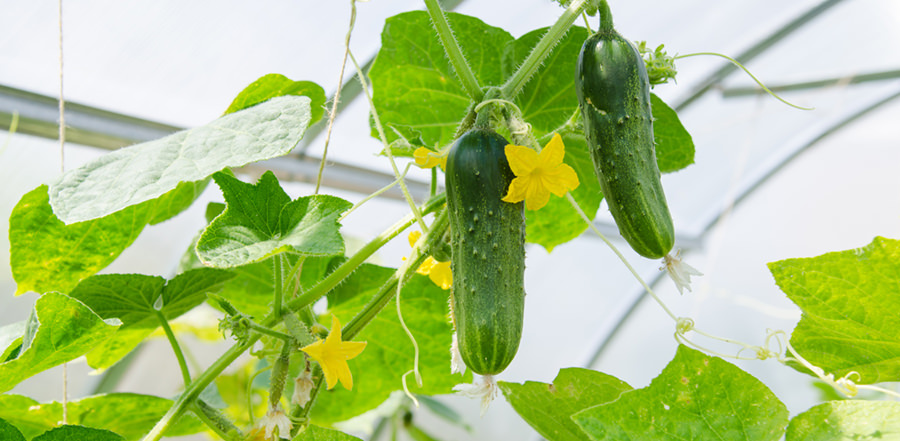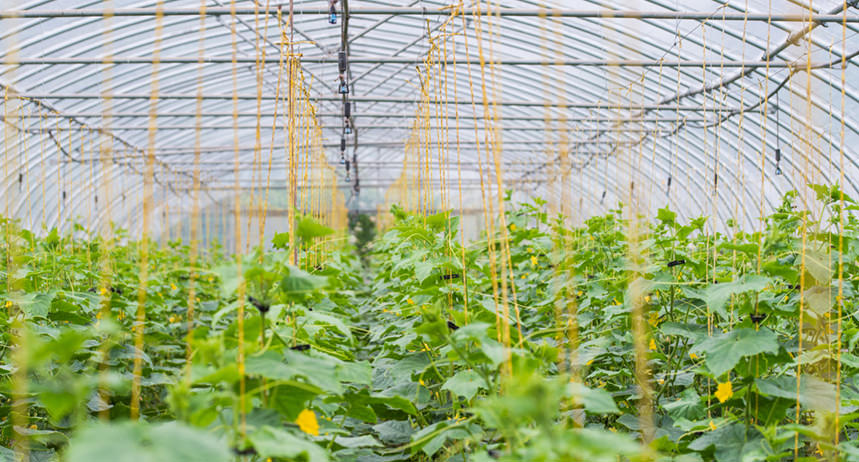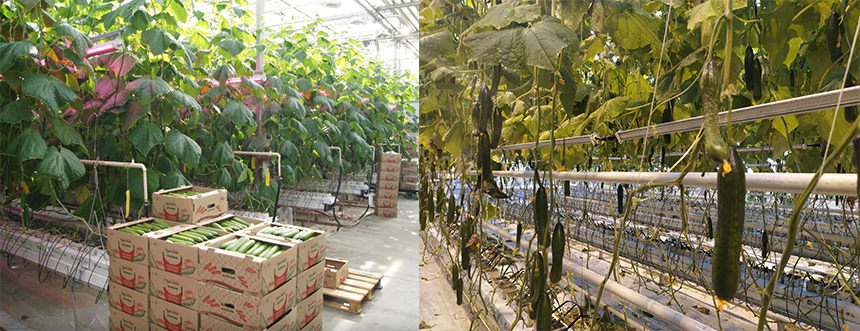How to Grow Well Greenhouse Cucumber
Cucumbers are popular as the fresh green appearance and mild sweet flavor. They are also rich in water and vitamin K, which are beneficial for our health. Cucumber is one of the common vine crops in commercial greenhouse cultivation. They root in the ground and grow with the support of trellises. There are various cultivars of cucumber. Some of them are seedless with thin skins, while others are seeded with bumpy skin. When it comes to select a cucumber cultivar for greenhouse, growers should consider the fruit quality, yield, disease resistance, fruit size, etc. Regular and timely efforts are required for managing greenhouse cucumber. This post will introduce the crop schedule (including sow, transplant, training, pruning and harvest) and mainly environment factors ( temperature and lighting) for growing cucumber in greenhouse.
Sow & transplant
The best time for sowing cucumber seeds is in late winter or early spring. Sow 1-2 seeds per cell about 0.5 inches deep in the plug trays. It takes about two to four weeks from sowing to transplanting, depending on locations and cultivars. Cucumber seeds germinate in 2 or 3 days at temperature of 27 °C to 29 °C. Maintain this temperature range until seedlings emerge. Once the seedlings appear, lower the temperature to 22 -24 °C at day time and about 21 °C at night. Seedlings should never be stressed by water or nutrients. Thus, growers should reduce the water supply at this stage. Optimum DLI (Daily Light Integral) in this period ranges from 13 to 16 mol·m¯²·d¯¹ and photoperiod is 18 to 20 hours (based on 24-hour period).
When seedlings grow up three or four true leaves, they are ready to be transplanted. What growers should pay attention to is the growth habit of seedlings. Seedlings for transplanting should have a upright growth habit without curves in the stem. Transplant the seedlings to grow bags or other containers after making sure the minimum ambient temperature in greenhouse is of 16 °C to 18°C. Since cucumbers require a large number lights for growing, keep enough space to make sure each plant can be shined.
Training
Cucumbers have large leaves and the lower part of plants may be shaded by upper leaves. Trellising and training are used to support and space cucumbers plants, allowing lower leaves or fruits absorb more light and keep the plants grow vertically. Generally, trellis strings are hung on the roof purlins of greenhouse. Then strings are attached or wrapped the stem above the soil surface. If the plants are grown in a larger size, growers can take some vine clips to attach the strings with plants and support vertical growth. Growers should keep in mind that avoid wrapping the string or clips over developing fruit. Otherwise, they will harvest monstrous cucumbers.
There are two training system for greenhouse cucumbers, vertical cordon and inclined cordon system. Vertical cordon system supports the plants with the help of an overhead wire and train them grow up vertically. Then prune the plants when they reach the top of wire. Inclined training system spaces the plants about 12 inches apart in each row and each row are about 5 feet apart. Distance of two wires is about 30 inches. Plants are then tied up the string and they will incline apart from the row center.

Pruning
Pruning is aimed to improve vegetative growth and maximize fruit production. A widely used pruning method called ‘umbrella system’ is used for both vertical cordon and inclined cordon training system. Umbrella pruning system allows more energy transferred to produce fruit instead of growing large amount of foliage. Growers are supposed to prune out all lateral branches and stop it when the main stem reaches the top wire. When one or two leaves grow above the top wire, remove the leaves and terminal buds of main stem. Two or three secondary branches or lateral buds near the top of plant are allowed to grow. Then use the same method to remove lateral branches or buds, keeping the plant growing downward. Furthermore, remove the developing fruits up to 30 inches of the main stem once they appear. However, fruits above the 30 inches of the main stem are permitted to grow. This process increases fruit quality and quantity. As a result, main stem has higher productivity than laterals. Total fruit production is also maximized.
Production
It takes about 3 to 4 weeks from transplanting to harvest. Seedlings grow larger leaves and robuster stem over time, then move to flowering. Water supply should be carefully controlled at flowering stage. Growers often utilize bees and labor pollination to enlarge yield in greenhouse. Plants will develop fruits after 6 or 14 days after bloom. Increase water supply is a good solution to offer sufficient energy for fruiting. Each node may develop single or several fruits. To ensure sufficient energy for fruiting, prune the fruits to a single fruit for each node. Additionally, remove all the distorted fruits because distorted fruits will not only being negative to marketable price, but also fight over nutrient with normal fruits. Optimum DLI (Daily Light Integral) for production ranges from 20 to 35 mol·m¯²·d¯¹ and photoperiod is 18 to 20 hours (based on 24-hour period). Maintain temperature about 22 - 24 °C at day time and 17 - 21 °C at night at production stage.
Fruits mature gradually from tapered to uniformly cylindrical. It is time to harvest when they are of uniform length and shape but the blossom ends are not yellow. Harvest can lasts about 2 to 3 months. Therefore, frequent and timely harvest is required to avoid over-mature. Growers can harvest fruits by clipping or twisting the stem. Clipping the fruit stem is a more common way for harvest. But growers should be aware of the importance of sanitation of tools, or they will damage the plants. Moreover, growers are required to avoid cut down the developing fruits.
To sum up, here is a table of recommended environment factors for greenhouse cucumbers
|
Growing Stage |
DLI (mol·m¯²·d¯¹) |
Photoperiod (hour) |
Temperature (day) (°C) |
Temperature (night)(°C) |
Water |
|
Sow |
- |
- |
27 - 29 |
|
Reduce water supply |
|
Seedling |
13 - 16 |
18 - 20 |
22 -24 |
21 |
Carefully control water supply |
|
Production |
20 - 35 |
18 - 20 |
22 -24 |
17 - 21 |
Increase water supply |
From the table above, it is clear that cucumber needs a large amount of light. However, there is no doubt that natural light cannot meet the lighting needs during cloudy days or winter. LED supplemental lights are capable of increasing yield and accelerating growth rate. Researches found that the yield was increased 70% to 80% with LED supplemental lights compared to solely natural light. Furthermore, LED supplemental lighting was found to bring forward the harvest time over 2 weeks. Earlier harvest means primary price and more profits for growers. In consequence, LED supplemental lights are vital for greenhouse cucumbers. Atop provides HL01 Horti-Bar and HL03 Horti-Reina for greenhouse cucumbers. HL01 Horti-Bar has LEDs on both sides, it can light two rows of plant. Interlighting connection makes it easier to install. Horti-Reina features a narrow-profile design that minimizes the interception of light. It emits sideward light distribution, allow lower leaves get optimal uniform light and result in an increase yield.


